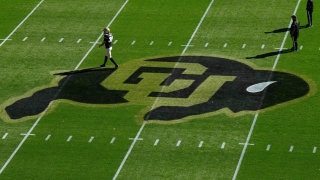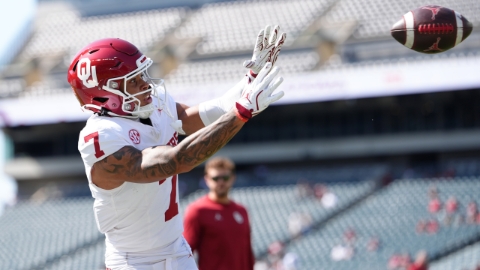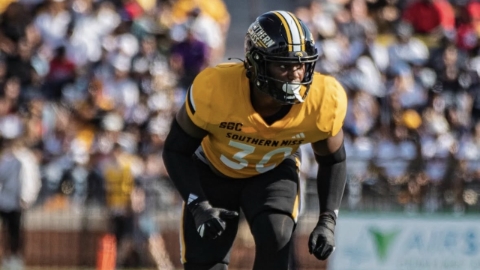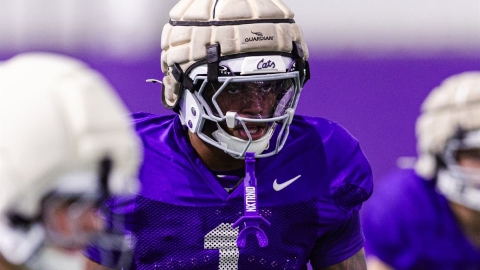Realignment Thoughts As Colorado Goes "Big 12 Prime" Instead Of "Pac 12 After Dark"
Colorado pulled the trigger on a move that had been discussed for almost a year now on July 27. Now the Pac-12 is down USC, UCLA, and Colorado while the Big 12 isn’t just back to 12, they have 13 and possibly more coming.
Let’s take a look at several realignment issues that are swirling currently.
What does Colorado add to the next Big 12 MMR negotiation?
When it comes time to renegotiate the multimedia rights for the Big 12, Colorado adds a solid brand with a national title, Heisman winner, and older successes along with the ability to reliably draw solid ratings in the three media markets (Denver, Colorado Springs, Grand Junction) that combine to cover their state with a combined 2.26M households. Additionally, the program offers the potential to play “After Dark” games in the fourth time slot providing potential added inventory to sell that the Big 12 currently can only offer via BYU. The Buffs played TCU in that time slot in 2022.
Colorado was one of the biggest offseason storylines with new coach Deion Sanders which over the short term could create some buzz for the program nationally despite it’s recent record.

Colorado was one of the weaker performers in my viewership data among the Pac 12 in league games excluding SC & UCLA from 2013-21 adjusted by number of games. However Colorado has typically been very weak on the field which is certainly dampening their performance below what a more reasonable record would lead to.
The Buffs have had some decent showings with individual years where the team was solid if we look at average viewers per league game excluding title games and departing members.
In the 2016 season where the Buffs won the Pac 12 South, they finished No. 2 behind Washington in average viewers per league game and had big numbers against Wazzu & Utah. They were also No. 2 that year if you look at all games and not just the isolated figure.
Additionally, CU has put up some big numbers in non-conference play against Nebraska and Texas A&M averaging over 3.78mm and averaging just under 1mm in a series vs Colorado State who averages only 681k against others and has no games over 1mm not involving their one series with Alabama or against CU.
Its Pac 12 title matchup against Washington drew more viewers than only three Pac-12 title games ever and outdrew eight of them. Colorado hasn’t been a ratings juggernaut but like many in the new Big 12 it has the upside to deliver as long as the team is solid.
What pushed the Pac 12 to this point?
The same thing that has driven virtually all realignment since the 80’s- television money and exposure. Once USC & UCLA went to the Big Ten it was going to be tough. Passing on a lower than desired number from ESPN & FOX to chase dollars that were not there ultimately was a crushing mistake. They could have had a deal slightly less than the Big 12 alongside them but instead foolishly tried to chase deals at 50 million per school valuations the numbers simply did not support if some of the rumored figures are correct.
Leagues have become unstable when the media rights puzzle isn’t solved.
- The SWC lost Arkansas & ultimately wound up in a partial merger since neither they or the Big 8 had more than 7-8% of the nation’s tv sets. For the Big 8, this prevented an inital loss of Colorado, Missouri, Oklahoma, and possibly Nebraska for another decade or two.
- The WAC grew too fast chasing schools in extra TV markets without enough market penetration. Rice, SMU, TCU, Tulsa, UNLV, and San Jose State added lots of TV sets in theory but couldn’t deliver them in enough viewership. Money got tight and a few years later Utah, BYU, Air Force, CSU, Wyoming, New Mexico, UNLV, and San Diego State all secretly met at a Denver airport to abandon the rest to form the MWC.
- The Big 12 passed on making their own network and then signed a very low FOX deal in hindsight. It was competitive with tier two deals before it but the Big Ten Network reset that market and began throwing off 6 million dollars to each school per year for tier two rights the Big 12 only got 1.6M for. The tier 1 contract was good but the next level of rights wasn’t effectively monetized which got Mizzou looking, which got CU looking, which got UT looking...
- A little over a decade ago the Big East passed on an ESPN deal that would be competitive and went to open market. The ACC who had a deal with ESPN then raided away Pitt, Syracuse, and later Louisville.
- The Mountain West’s failing league network and poor exposure led to them losing BYU who chased ESPN & BYUtv exposure into independence in football.
- Conference USA’s awful exposure allowed the Sun Belt (a league they had raided) to come back and take several teams.
There are plenty of examples of how things didn’t work out right for leagues. The Pac 12 compounded this over the years by repeatedly passing on expansion opportunities that would have built them up.
- Passed on the opportunity to add ANY of the current Big 12 in 2021
- Passed on adding BYU for 30+ years despite obvious value
- Passing on adding OU & OSU in 2011 when they would have come on their own.
- Letting the LHN and a preference to avoid BU get in the way of a PAC 16 or at minimum slow down a deal that would have made them a superconference.
- Passing on Texas in the 90’s when Stanford allegedly voted against.
To say it’s been bad choices is an understatement.
Did the academic affiliation with the Pac 12 impact things?
When it comes time to realignment school presidents make decisions and academics are a consideration. However for all the hyperbole that schools “make more money on research” or “athletics is such a small percentage of a school’s budget” it’s clear that whatever benefit they get from that affiliation isn’t able to monetize directly enough or consistently enough to stop regents from pursuing better athletic dollars due to fiduciary duty.
I see it as a first world consideration in realignment- when the money is right they will absolutely prefer an academic heavyweight to a weaker school. When it isn’t? The ACC had some concern about their football schools getting wandering eyes and therefore added Louisville instead of the academically more prolific UConn. and Colorado left associating with Cal, Stanford, Washington, and Oregon for a difference of less than 20M dollars per year. If any of this conference affiliation drove any significant amount of that research total it wouldn’t be happening this way and Rice would not have been the SWC member every single other team left behind.
What Does This Mean For A Pac 12 Media Deal?
It obviously hurts the upside significantly. Colorado was the only school other than Washington with a modern era national title, was one of only three schools to win a Heisman, and was a strong program for the 25 years leading up to their joining the Pac 12.
- For Linear Partners: The above factors and their basic viewership trends are significantly better than any of the replacements rumored to be potentially backfilling the Buffaloes for a national linear broadcaster that wants programs that get solid viewership and have the potential to go really big if they have success. Losing some league interest for other games in the state with over 2M households also hurts. Fans in Denver have much less reason to tune in and care about Washington vs Stanford compared to before. Potential replacement options SMU, SDSU, and CSU have fewer combined cumulative regular season viewership on Nielsen rated networks since 2016 than CU so brand awareness among casual fans likely takes a hit.
- For a Streaming Provider: For partners like Apple which is the presumed partner for the PAC 12 now, the loss of Colorado who would sell more subscriptions is rough compared to any G5 backfill. CU sold out of season tickets in a 50,000 seat stadium with only 12,000 reserved for students, They also just put almost 50,000 fans in their stadium for a spring scrimmage. It is a layup that the Buffaloes would have sold MUCH more subscriptions than teams that typically have half of that in “tickets distributed” for a typical home game. CU sells almost four times the ticket revenue than SDSU or CSU does even before the “Prime Effect”. Even if part of that is schedule related it’s hard to rationalize it being a remotely even swap in diehard fan demand.
- For The Pac 12 Network: The Pac 12 Network’s primary feed reportedly has 14.8 million subscribers paying an average of 13 cents per subscriber monthly. This includes a low rate outside the footprint and a high rate inside the Pac 12 footprint which in 2015 was reportedly 80 cents. This 13 cents monthly applied to 14.8 million subscribers estimates to around 23M annual revenue from carriage fees for that primary network.
The Pac 12 also has six regional networks with two teams each that combine for 8.5M subscribers and the carriage fees for those range from a low of 52 cents for the Oregon schools and a high of 98 cents for the Washington schools. If we get extremely conservative and run with the 52 cents for all 8.5M we get another 53M while if we project 75 cents we get 99M. This is in line with some previous Jon Wilner projections. That’s going to be a huge part of their revenue of 117M that the Pac 12 reported recently. When expenses are 77M it’s hard to see it being a beneficial network to continue if you lose at least 35% of that in-footprint base as Colorado’s 3 DMA’s make up 9.5% of that footprint while Los Angeles was another 25%. That’s going to be a big blow.
Can expansion improve it? Years ago TCU and San Diego State struggled to get the Mountain West’s now defunct network “The Mtn” distribution when TCU was in their pre-Big 12 peak so I have my doubts that SMU & SDSU will fare much better for P12N unless the cable distributor’s wrote their agreements poorly.
In all three primary avenues this one hurts much more than any jokes about their recent on-field record would imply.
Opinions on a Big Ten Addition of Oregon & Washington
It’s no secret that the Ducks and Huskies are flirting with the Big Ten and that Stanford and Cal are right behind them. Does it make sense for all involved? I could see it either way.
Washington and Oregon are the best television draws left in the Pac 12 and academically they’d be solid fits. However, there are a few issues with Big Ten expansion currently.
Firstly, how do you pay for it? My understanding is that the Big Ten isn’t working with a pro-rata clause and would effectively need to sell the roughly 13 additional games of inventory to a new partner. So who could that be and what issues arise on how to pay for it even if the newcomers were able to take half shares?
- One Easy Source Of Revenue Is The Big Ten Network: According to one report USC & UCLA joining helped the Big Ten go from 10 cents per subscriber in the Los Angeles DMA to 1.50 per subscriber. If that’s a flat rate negotiated nationally that’s going to be huge to get possibly 78.5mm more dollars per year out of the 4.675M households in the 7 DMA’s that make up those two states. Even if they have to negotiate a much lower rate this part is promising as a 50 cent increase would project to 28mm.
- Exclusivity In Their Contract May Be A Problem: From the reporting of the deal it appears that among over the air linear providers like CBS, NBC, FOX, ABC, etc there is an exclusivity for FOX to be the only carrier for Big Ten games at noon eastern, CBS at 3:30, and NBC in prime time. This leaves only the late night slot for Saturdays where ESPN gets 1.6mm typically and FS1 gets less than 500k. If we use the 3.76 per likely viewer I estimated off the SEC deal in a prior article I only get between 24 and 78 million dollars for thirteen games. Even at reduced shares it’s tough to see that making more money for existing members once other revenue streams are divided two more ways.
The FOX owned Big Ten Network and Fox Sports 1 appear to be exceptions here (as the BTN is majority owned by FOX who owns all the Big Ten rights) but does that exception extend to a Turner, CW, Amazon, Apple, or others? That could limit who can help pay the freight here with Saturday games.
- Will Media Partners, Presidents, & AD’s Play On Friday or Thursday? This would be one way around contractual exclusivity but is their appetite to do so when they are already paid so much? Would the existing schools go for it? Would the potential TV partners have openings there where they wouldn’t be eating sunk costs on other programming? If these windows are refused on either side that’s one avenue for big dollars that is shut. Remember that these are prime time or late games typically and this conference has recently been butting heads with NBC over late season prime time games.
- Will Linear Media Partners Pay Enough For 13 Games AFTER FOX, NBC, and CBS pick nearly 44-50 Games First? Nobody doubts that the Big Ten has a deep roster of great games. However once you get past the top 50 performing home games for this 18 team group in 2022 you end up with games that drew between 1.1-1.6M viewers making up the next seven games the data I compiled from Sports Media Watch. Linear partners may have an issue with viewership potential that far down the selection order.
- Is There Any Appetite For A Streaming Service For Those Games? A streaming partner wouldn’t have the concerns with having a tier two game package as much because they’ll possibly hit subscription targets even if it’s some more modest games involving most of Nebraska, Ohio State, Michigan, Penn State, Wisconsin, and others. Those schools have large fanbases who are passionate. However, the Big Ten turned down Amazon in favor of both CBS and NBC who allegedly outbid them significantly. A partner like Amazon would certainly be able to make the money work even if they were at just 40% of what they would have paid for the 15-16 game NBC or CBS inventory. This can work but will the decision makers be on board? They turned down tens of millions NOT to do a streaming deal recently so would they reverse course here with a less prominent package of games?
- The next issue is travel. How much will the revenue compare to added travel concerns for eastern teams? Decision makers at Iowa, Nebraska, and Illinois would end up traveling west for games much more often. Is there enough upside to make them bother? Seattle & Eugene aren’t exactly easy bus trips from LA so they really don’t help the situation either.
- Finally, does it fit with their long term strategy? It could be a “we like you but we like our friends in the East more” situation where they will wait for other targets to shake loose rather than expand now.
What’s Your Take On The FSU & Big Ten Rumors?
If somebody can break free of a Grant of Rights in the ACC without spending tons I will be surprised. Texas and Oklahoma had years to figure it out and incentive to go and paid heavily to leave ONE year early. FSU is talking about leaving over a decade early? Good luck fighting it in court. That is a MASSIVE risk.
If you win, you get a LOT more revenue.
If you lose, it’s hundreds of millions.
Either way the lawyers get an awful lot of billable hours chipping away at your upside and piling on your downside risk.
I imagine the posture of other ACC schools who want out is going to be similar to this “Far Side” comic:

Speaking of the ACC... Why Wouldn’t ESPN Work To Move The Top Brands To The SEC?
Some very good reasons.
- Their Current Deal is GREAT For ESPN in Price: The ACC extended their deal multiple times since they signed it initally over a decade ago. They did it when they started their network and when they expanded. This has led to a deal that hasn’t caught up with market rates. To put it in perspective- the Big Ten sold 15-16 games to each of CBS and NBC that would compare pretty similarly to the ACC’s top 15 or so games for around 350 million per year. The entire television revenue for the ACC in the year before their network started was 288 million. ESPN would be crazy to pay more for the same product elsewhere.
- Their Current Deal Is GREAT For ESPN In Inventory & Minimums: They have a national contract with them where they really only have to put on some combo of Clemson, FSU, Miami, whoever hosts Notre Dame in a scheduling agreement and a handful of other games. They have around 34% of the ACC’s best games and can monetize the lesser ones without obligation to put them on ABC, ESPN, ESPN2, or ESPNU allowing them to maximize viewership overall.
- They Spent A Lot On An ACC Network That Is Making Them Money: The ACC Network is a partnership with ESPN and the ACC where ESPN had to spend a lot up front which is why they got such a long grant of rights. The ACC is making over 360M in carriage revenue currently and likely throwing off solid profits that could grow over time. ESPN isn’t going to damage a money maker to increase their cost when they are cost cutting.
Do You Think The ACC Would Add Pac 12 Teams?
I think the schools they want (Oregon, Washington, Stanford, Cal) all want the Big Ten. Those schools know their best bet is to be more able to move than the ACC schools wanting those spots can. I just don’t see those four signing up for a grant of rights through 2036.
Who Is Probably Next For The Big 12?
All signs point to Arizona. They’ve had the most rumors for the longest time and appear receptive. From there it’s probably going to see the Big 12 try and apply pressure on Washington and Oregon if the Big Ten does not act but possibly take some combination of Arizona State, Utah, or Stanford if the Big Ten does take the Huskies & Ducks. I could see the Big 12 go to either 14, 16, or 18 depending on who came when and how the networks value each school.
Will The Pac-12 Rebuild If Teams Leave?
As far as keeping the conference entity alive, it comes down to how many teams remain, can they leverage postseason revenue left with the league, and can they manage the exit fees that would prevent MWC and AAC schools from jumping over on a one year notice. Teams would presumably leave their NCAA tournament credits and the league has a relationship with the Rose Bowl and playoff that pays them tens of millions more than any G5 annually. Those can be utilized to potentially build a better league than the existing G5’s. With the fear of departures realized and over with the potential to take less revenue in order to get better exposure from a media partner is also there. A rebuilt PAC should dwarf any G5 in revenue even if it would be way behind any P5 league.
A big issue is exit penalties for teams leaving in just one year. Mountain West teams are on the hook for 34 million if they leave now to join in time for the 2024 season. Schools like SMU from the American have an exit fee of 10 million if they give 27 month notice but if they leave before that it increases to a negotiated amount.
If it’s just two or three schools it probably can’t build back. However if a nucleus of six schools remain it’s easy to see them take 3-4 G5’s and try to build back. It depends on who and how many.
Follow @Baylor_S11 on Twitter!



